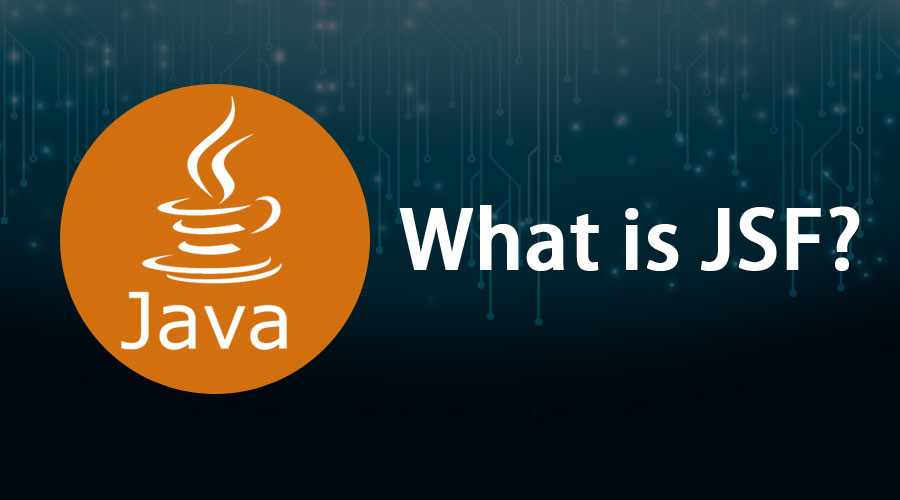Updated July 5, 2023
Introduction to JSF
JavaServer Faces (JSF) is a standard Java technology for building Web applications. Developing Java web interfaces is made more accessible by providing a component-based approach. It permits access to server-side data and logic. JavaServer Faces is an XML document designating formal components in a rational tree form. The JSF API offers components like commandButton, input Text, etc., and assists in managing their states. Java objects support JSF components and have several Java facilities, including databases, tag libraries, and remote APIs. The JSF Tag libraries add components on the web pages and connect them with objects on the server.
JavaServer Faces appeals to a diverse audience of developers as “Business developers” find JavaServer Faces development to be simple because of the drag-and-drop user interface (UI) components, while “System designers” get unparalleled programming flexibility because of the robust JSF API. JSF uses its architecture’s Model-View-Controller (MVC) design pattern, providing applications with more excellent maintainability.
The main idea behind the JavaServer Faces framework is encapsulating (or wrapping) client-side technologies like HTML, CSS, and JavaScript, permitting developers or designers to construct web interfaces without much interaction with the technologies. The latest version of JSF, JSF2, uses Facelets as its default templating system.
Features
The features of the JavaServer Faces are as follows:
1. Component-Based Framework: JavaServer Faces provides inbuilt components to help build web applications. HTML5, Facelet tags, etc., can be used.
2. Facelets Technology Implementation: JavaServer Faces uses Facelets as its default view handler technology. Facelets is an open-source web template system. It supports all of the JSF user interface components and concentrates on creating the view for a JSF application.
3. Expression Language Integration: Expression Language offers an effective mechanism for communicating the UI (web pages) with the application logic (managed beans).
4. Supports HTML5: JSF2.2 provides a way to include attributes of HTML5 to JSF components.
5. Easy and Prompt Web Development: It offers a rich collection of inbuilt libraries and tools which can be used to develop web applications rapidly.
6. Provide Internationalization: This allows applications to be created in various languages for various regions.
7. Bean Annotations: Annotations provide a feature that helps validate tasks in the Managed Bean rather than the HTML page.
8. Default Exception Handling: JavaServer Faces provide default exception handling to develop bug-free applications.
9. Templating: Templates help increase the reusability of these components.
10. Inbuilt AJAX Support: JSF provides AJAX support, which helps us render the request to the server side without refreshing the page.
How does it work?
Due to a component-focused UI model design, JSF uses XML files known as view templates or Facelet views. These Facelets process requests, load the accurate view template, develop a component tree, process events and render responses to the client. The state of the components is saved at the termination of each request in a process known as stateSaving (transient property= true) and is restored on the next creation of that view. The client-side or the server-side can save the objects and their states.
JavaServer Faces is often used with Ajax. Ajax combines application development techniques and technologies that make rich UIs possible. We can easily add Ajax-supported components to improve JSF-based UIs since JSF supports several output formats. The JSF 2.0 design offers built-in support for Ajax by providing development interfaces to Ajax events. It allows any client-triggered event to undergo proper verification. Then, it can invoke its methods before sending the result back to the browser using an XML DOM update.
Benefits of JSF
Some benefits are mentioned below:
- It provides a clear separation between the behavior and presentation of any web application. We can create business logic and user interface logic distinctly.
- These APIs are layered right on top of the Servlet API. This enables us to use several presentation technologies and also helps us to create our very own custom components.
- We designed it to use Facelets to create reusable components, which in turn enhance productivity and consistency.
- JavaScript code is embedded as a part of the component in JSF. This makes it less confusing for developers.
- It has a feature called Annotations, which reduces the manual configuration process for our applications.
- This provides a robust architecture for handling component states and their data, confirming user input, and handling events.
Drawbacks of JSF
The following are the drawbacks of JSF:
- The learning curve of JSF is steep, which is one of the main disadvantages of JSF.
- It is not suitable for high-performance applications.
- This phase listener feature is unusable, as there is no tight coupling between the phase listener and the managed bean.
- It is not scalable as it uses session objects to store the component’s state in a request.
How will JSP help in career growth?
Anyone who wants to work in maintaining legacy applications in the future will find this helpful because these applications may use JSF frameworks. It is also necessary to know JSF to migrate systems made in JSF to newer technologies. JSP helps us to do more with less code. Beyond this, for career growth, we nowadays recommend choosing an action-based framework that uses REST principles for simpler, more robust applications, like Spring MVC.
It solves many of the ancient problems of Java Web development by clearly implementing the MVC design pattern without sacrificing the flexibility of the application. Moreover, as JSF is a Java standard, it will continue to support an efficient development environment that will likely surpass other development environments. It helps simplify UI development but increases the complexity of processing the lifecycle of requests.
Recommended Articles
This has been a guide to What is JSF. Here we discuss the working, career growth, and Benefits of JSF. You can also go through our other suggested articles to learn more –




